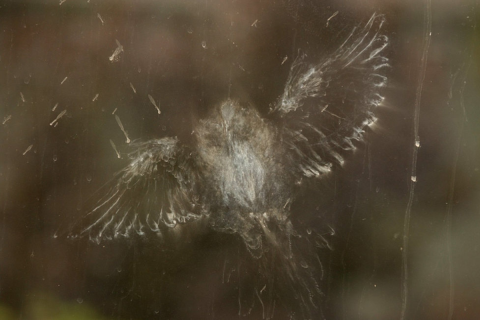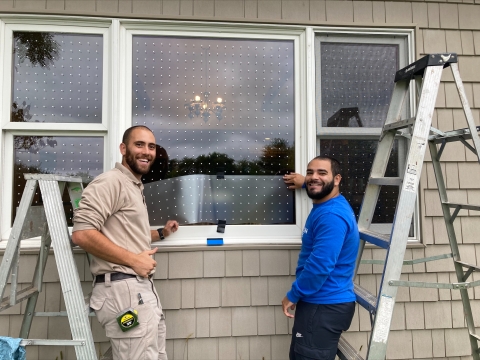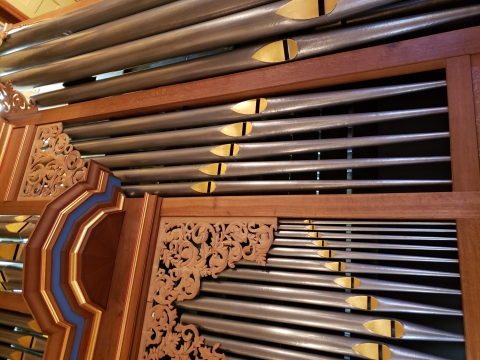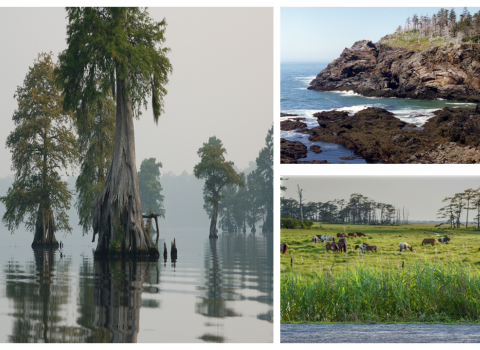From my desk at the U.S. Fish and Wildlife Service Northeast Regional Office in Massachusetts, I could hear the steady whirring and beeping of heavy machinery in the distance. Looking out a window down the hall, I saw a boom lift towering overhead, with a couple of people onboard working on the building’s exterior.
This was a Service MAT in action. MATs, or Maintenance Action Teams, are groups of maintenance professionals from various Service programs that lead short-term projects in support of our most important on-the-ground conservation goals. Team members had arrived at our office early that week for one such project: retrofitting the building’s windows with a special material designed to prevent deadly bird collisions.
The office has a lot of area to cover – it’s three stories tall and wrapped by windows – but the outcome is worth the effort, said Pam Toschik, assistant regional director of our Migratory Birds program.
“Every year nearly one billion birds collide with glass in the United States,” Toschik said.
That’s billion with a “B”. Since 1970, an estimated three billion birds – or one in four – have vanished from the continent’s total population; collisions are a significant contributor to this decline. Glass windows are dangerous to birds because they reflect their surrounding environment – like forest, clouds or sky. Birds, unable to recognize the surface as a barrier, see natural habitat mirrored in the reflection and fly directly into the glass.
After collisions, some birds may be only temporarily stunned and without lasting injury. In many instances, however, birds are killed, never to fly again.
When an adhesive pattern of small dots is applied to windows, birds recognize them as barriers and steer clear. It’s a simple solution poised to reap tremendous benefits for local birds, Toschik explained.
But this project is by no means a one-off. Through the collaboration of our regional staff in the Migratory Birds program, those at national wildlife refuges and fish hatcheries and field stations, and our talented maintenance pros, we’re scaling up our collision-prevention efforts to ensure birds keep soaring safely, wherever they go.
Assessing the situation
In Summer 2021, three interns with the Service’s Directorate Fellows Program piloted the Bird Safe Building Survey here in the Northeast. This survey is a nationwide initiative of our Migratory Birds program that allows Service staff to assess their respective facilities for collision risk and find solutions to reduce it.
The Fellows visited prominent facilities in the region, where they gathered data on factors that can influence the rate of bird collisions – things like the number of windows, lighting practices at night (lights disorient birds too), and the building’s surrounding habitat. From these surveys, they issued reports to refuge and hatchery managers on how they can take action and created a ranked list of the top 15 facilities, based on collision risk.
“The goal was to find those ‘problem children’ buildings, and places we need to do better,” said Kevin Ortyl, chief of the Infrastructure Management Division for the region, who helped spearhead the effort.
Funding for the necessary materials to retrofit the selected buildings will come from the Infrastructure Management Division. After that, all that’s needed is the know-how for staff to get the job done. That’s where our team of maintenance pros come in.
Maintenance team, assemble!
Back at the regional office retrofit, Darren Stover, regional heavy equipment manager and MAT Program Lead, and Allen Peake, Logistics Management Specialist, took a break from laying down dots on the remainder of our office windows to talk through the work. But first, they offered a chance for a couple of us office folks to get a bird’s-eye view of the project. Yes, literally.
Donning hard hats and safety harnesses, we stepped into the boom with Stover. He fired up the engine, and we ascended alongside the building’s exterior. Down below, I could see robins and catbirds jetting through the trees framing the building’s entrance.
Stover’s team had made quick work of the office windows, with the patterned material now covering most of them. Reflections of trees and clouds still appeared in the glass – only now their mirrored images were clearly disrupted by the dots to dissuade any misguided birds.
For Stover, mastering the installation process took trial and error, patience, and, funny enough, online how-to videos. “I say that we’re ‘YouTube-certified’,” he said over the grumbling motor of the boom lift.
While he jokes, Stover’s DIY-attitude is key to how these MATs function. Over the summer, he helped organize and lead the regional 2022 Maintenance & Managers Workshop, which brought the region’s facility managers and maintenance staff together at the Patuxent Research Refuge in Maryland to meet and train on Service priorities. There, Stover and his team held a session for employees on how to retrofit building windows, with the refuge visitor center serving as their practice canvas.
That on-the-job training is the real, long-lasting benefit this team is providing, Stover told us. With the new skills under their belt, our Service staff have returned home to start making their buildings safer for birds.
From stovepipes to organ pipes
Make no mistake – there’s a long road ahead. The good news is we’re not going it alone.
In addition to her main job as head of Migratory Birds in our region, Pam Toschik helps lead the Service’s National Collisions team. Through this national network, regions are working closely to drive long-term goals and milestones for bird-strike reduction efforts within the agency. The team serves as a hub to share lessons-learned and outreach materials internally and with partners, non-profit organizations, other government agencies, and the general public.
The Service’s national deputy assistant director for Migratory Birds, Noah Matson, stressed the all-hands approach it will take to address these challenges on a nationwide scale. He likened it to the coordination required to play the pipe organ – a complex-but-rewarding instrument: “We need to shift our mindset from operating in organizational stovepipes to thinking of our organization as pipe organs. Each organ pipe makes an individual sound. But played together, they make powerful music. But learning how to make that music takes a composer years of practice…both hands, all ten fingers, and both feet. Right now, we’re playing a rudimentary composition, but we have the opportunity to grow our skills and make beautiful music together,” he said.
Brian Smith, the Deputy Assistant Regional Director for Migratory Birds and Science Applications in the Service’s Mountain-Prairie Region, also sits on the team. He emphasized how crucial collaboration has been to building momentum on this work in his own region. “There’s no way we can do this all ourselves,” Smith said. “The more we can work together on this, the bigger the effect we’ll have.”
With plans to relocate the Mountain-Prairie Regional Headquarters to the Federal Center in Denver, Colorado – a building complex housing many government agencies – Smith’s hope is that retrofitting their new building will also send an important message that inspires other government agencies outside of the Service to follow suit.
“I think it’s really important to be visible in what we’re doing and tell the story as to how we can help reduce collisions – not only in our buildings but help to influence others throughout the federal government and in our communities,” he said.
There are great examples of other Service buildings telling that story across the country, with retrofits at places like Minnesota Valley National Wildlife Refuge in Minnesota and Ottawa National Wildlife Refuge in Ohio. In New Mexico, the Valle de Oro National Wildlife Refuge Visitor Center was designed to be bird-friendly from day one.
Furthermore, the Service recently enacted a national policy change requiring all new building leases to be bird-friendly. The Service aims to eliminate bird collisions at its facilities by Fiscal Year 2031.
The target is ambitious, no doubt, but when Toschik sits in her newly improved office, she rests easy knowing that success is within reach.
“I’ve sat in this building for eight years and have had many birds collide with my windows,” she said. “It’s really hard to sit here working on bird conservation and hear birds colliding and know that there are solutions out there. I’m really grateful for our agency and hopeful now that we’ll be doing this much more widely, and inspire others to take action at their homes, offices, and schools to save birds.”
Click here to learn more about bird collisions and what you can do to prevent them.







